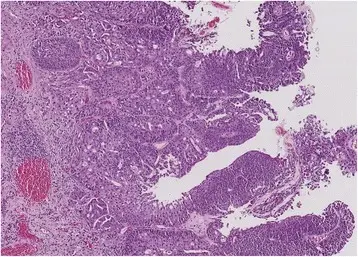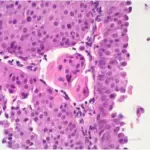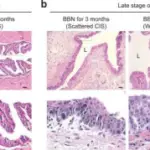High-grade papillary urothelial carcinoma is neoplastic proliferation of the urothelium with a papillary configuration and no invasion beyond the basement membrane.
What is the Pathology of High-Grade Papillary Urothelial Carcinoma?
The pathology of high grade papillary urothelial carcinoma is:
-Etiology: The cause of high grade papillary urothelial carcinoma is smoking, occupational exposure to chlorinated hydrocarbons, polycyclic aromatic hydrocarbons and aromatic amines, arsenic exposure.
-Genes involved: TP53, PIK3CA, TSC1, HRAS, APC.
-Pathogenesis: The sequence of events that lead to high-grade papillary urothelial carcinoma is genetic alterations.
-Histology: The histology associated with high grade papillary urothelial carcinoma shows fibrovascular cores lined by neoplastic urothelium, complex, solid to fused papillae common.
How does High-Grade Papillary Urothelial Carcinoma Present?
Patients with high-grade papillary urothelial carcinoma typically affect males more than females at 70 years of age. The symptoms, features, and clinical findings associated with high-grade papillary urothelial carcinoma include painless, intermittent hematuria, gross hematuria associated with a more advanced pathologic stage.
How is High-Grade Papillary Urothelial Carcinoma Diagnosed?
High-grade papillary urothelial carcinoma is diagnosed by cystoscopy, ultrasound, CT scan, and biopsy.
How is High-Grade Papillary Urothelial Carcinoma Treated?
High grade papillary urothelial carcinoma is treated by transurethral resection of the tumor.
What is the Prognosis of High Grade Papillary Urothelial Carcinoma?
The prognosis of high grade papillary urothelial carcinoma is poor with a high mortality rate.



